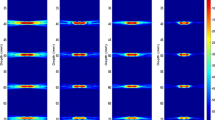Abstract
Purpose
A number of studies aimed at improvement of ultrasound image quality, such as spatial resolution and contrast, have been conducted. Apodization is known as an important factor that determines image quality. However, in the case of amplitude and phase estimation (APES) beamforming, a kind of adaptive beamformer that has been employed in medical ultrasound recently, only rectangular apodization has been used in the previous studies. In this study, apodization was employed in adaptive beamforming, and its effects on image quality were examined in phantom experiments.
Methods
We recently proposed a modified APES beamformer that reduces the computational complexity significantly using sub-aperture beamforming. In this study, the total receiving aperture was divided into four sub-apertures, and the APES beamforming was applied to the output from the four sub-apertures. Before the delay-and-sum (DAS) beamforming in each sub-aperture, echoes received by individual transducer elements were apodized with rectangular, Gaussian, and two Hanning functions, where the apodization with two Hanning functions realized lateral modulation of the ultrasonic field. The lateral spatial resolution was evaluated by the full width at half maximum of an echo from a string phantom, and the image contrast was evaluated using a cyst phantom.
Results
The modified APES beamformer realized a significantly better spatial resolution of 0.38 mm than that of the conventional delay-and-sum beamformer (0.67 mm), even with rectangular apodization. Using Gaussian apodization, the spatial resolution was further improved to 0.34 mm, and contrast was also improved from 4.3 to 5.1 dB. Furthermore, an image obtained by the modified APES beamformer with apodization consisting of two Hanning functions was better “tagged” as compared with the conventional DAS beamformer with the same apodization.
Conclusion
Apodization was shown to be effective in adaptive beamforming, and an image obtained by the adaptive beamformer with lateral modulation seemed to have potential for improvement of the accuracy in measurement of tissue lateral motion.












Similar content being viewed by others
References
Shattuck DP, Weinshenker MD, Smith SW, von Ramm OT. Explososcan: a parallel processing technique for high speed ultrasound imaging with linear phased arrays. J Acoust Soc Am. 1984;75:1273–82.
Tanter M, Bercoff J, Sandrin L, Fink M. Ultrafast compound imaging for 2-D motion vector estimation: application to transient elastography. IEEE Trans Ultrason Ferroelectr Freq Control. 2002;49:1363–74.
Hasegawa H, Kanai H. Simultaneous imaging of artery-wall strain and blood flow by high frame rate acquisition of RF signals. IEEE Trans Ultrason Ferroelectr Freq Control. 2008;55:2626–39.
Honjo Y, Hasegawa H, Kanai H. Two-dimensional tracking of heart wall for detailed analysis of heart function at high temporal and spatial resolutions. Jpn J Appl Phys. 2010; 49:07HF14-1–9.
Provost J, Gambhir A, Vest J, Garan H, Konofagou EE. A clinical feasibility study of atrial and ventricular electromechanical wave imaging. Heart Rhythm. 2013;10:856–62.
Shahmirzadi D, Li RX, Konofagou EE. Pulse-wave propagation in straight-geometry vessels for stiffness estimation: Theory, simulations, phantoms and in vitro findings. J Biomech Eng. 2012; 134:114502-1–6.
Hasegawa H, Hongo K, Kanai H. Measurement of regional pulse wave velocity using very high frame rate ultrasound. J Med Ultrason. 2013;40:91–8.
Bercoff J, Montaldo G, Loupas T, Savery D, Mézière F, Fink M, Tanter M. Ultrafast compound Doppler imaging: providing full blood flow characterization. IEEE Trans Ultrason Ferroelectr Freq Control. 2011;58:134–47.
Yiu BY, Yu AC. High-frame-rate ultrasound color-encoded speckle imaging of complex flow dynamics. Ultrasound Med Biol. 2013;39:1015–25.
Takahashi H, Hasegawa H, Kanai H. Echo speckle imaging of blood particles with high-frame-rate echocardiography. Jpn J Appl Phys. 2014; 53:07KF08-1–7.
Jespersen SK, Wilhjelm JE, Sillesen H. Multi-angle compound imaging. Ultrason. Imaging. 1998;20:81–102.
Montaldo G, Tanter M, Bercoff J, Benech N, Fink M. Coherent plane-wave compounding for very high frame rate ultrasonography and transient elastography. IEEE Trans Ultrason Ferroelectr Freq Control. 2009;56:489–506.
Hasegawa H, Kanai H. High-frame-rate echocardiography using diverging transmit beams and parallel receive beamforming. J Med Ultrason. 2011;38:129–40.
Papadacci C, Pernot M, Couade M, Fink M, Tanter M. High-contrast ultrafast imaging of the heart. IEEE Trans Ultrason Ferroelectr Freq Control. 2014;61:288–301.
Camacho J, Parrilla M, Fritsch C. Phase coherence imaging. IEEE Trans Ultrason Ferroelectr Freq Control. 2009;56:958–74.
Hasegawa H, Kanai H. Effect of sub-aperture beamforming on phase coherence imaging. IEEE Trans Ultrason Ferroelectr Freq Control. 2014;61:1779–90.
Hasegawa H. Enhancing effect of phase coherence factor for improvement of spatial resolution in ultrasonic imaging. J Med Ultrason. 2016;43:19–27.
Capon J. High-resolution frequency-wavenumber spectrum analysis. Proc IEEE. 1969;57:1408–18.
Synnevåg JF, Austeng A, Holm S. Adaptive beamforming applied to medical ultrasound imaging. IEEE Trans Ultrason Ferroelectr Freq Control. 2007;54:1606–13.
Holfort IK, Gran F, Jensen JA. Broadband minimum variance beamforming for ultrasound imaging. IEEE Trans Ultrason Ferroelectr Freq Control. 2009;56:314–25.
Synnevåg JF, Austeng A, Holm S. Benefits of minimum-variance beamforming in medical ultrasound imaging. IEEE Trans Ultrason Ferroelectr Freq Control. 2009;56:1868–79.
Blomberg AEA, Holfort IK, Austeng A, Synnevåg JF, Holm S, Jensen JA. APES beamforming applied to medical ultrasound imaging. In: 2009 IEEE Intern’l Ultrason. Symp. Proc. pp. 2347–50.
Hasegawa H, Kanai H. Effect of element directivity on adaptive beamforming applied to high-frame-rate ultrasound. IEEE Trans Ultrason Ferroelectr Freq Control. 2015;62:511–23.
Hasegawa H. Improvement of penetration of modified amplitude and phase estimation beamformer. J Med Ultrason. 2016 (in press).
Jensen JA. A new method for estimation of velocity vectors. IEEE Trans Ultrason Ferroelectr Freq Control. 1998;45:837–51.
van Wijk MC, Thijssen JM. Performance testing of medical ultrasound equipment: fundamental vs. harmonic mode. Ultrasonics. 2002;40:585–91.
Thijssen JM, Weijers G, de Korte CL. Objective performance testing and quality assurance of medical ultrasound equipment. Ultrasound Med Biol. 2007;33:460–71.
Acknowledgements
The author thanks Mr. Takeshi Sato at Toshiba Medical Systems Cooperation for valuable discussion on sub-array averaging. This study was partly supported by JSPS KAKENHI Grants, Nos. 26289123 and 15K13995.
Author information
Authors and Affiliations
Corresponding author
Ethics declarations
Ethical considerations
No animal and human subjects were used in this study.
Conflict of interest
None.
About this article
Cite this article
Hasegawa, H. Apodized adaptive beamformer. J Med Ultrasonics 44, 155–165 (2017). https://doi.org/10.1007/s10396-016-0764-3
Received:
Accepted:
Published:
Issue Date:
DOI: https://doi.org/10.1007/s10396-016-0764-3




